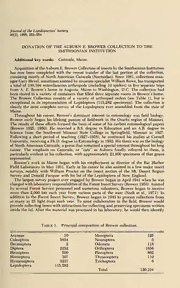
Donation of the Auburn E. Brower collection to the Smithsonian Institution PDF
Preview Donation of the Auburn E. Brower collection to the Smithsonian Institution
JournaloftheLepidopterists'Society 49(3), 1995, 253-254 DONATION OF THE AUBURN BROWER COLLECTION TO THE E. SMITHSONIAN INSTITUTION Additional key words: Catocala, Maine. AcquisitionoftheAuburnE. BrowerCollectionofinsectsbytheSmithsonianInstitution has now been completed with the recent transfer of the last portion of the collection, consisting mostly of North American Catocala (Noctuidae). Since 1981, collections man- agerGaryHevel,sometimesassistedbymuseumspecialistWilliamRowe, hastransported a total of 130,104 miscellaneous arthropods (including 10 spiders) in five separate trips from A. E. Brower's home in Augusta, Maine to Washington, D.C. The collection had been stored in a variety of containers that filled three separate rooms in Browers home. The Brower Collection consists of a variety of arthropod orders (see Table 1), but is exceptional in its representation of Lepidoptera (115,282 specimens). The collection is clearly the most complete survey of the Lepidoptera ever assembled from the state of Maine. Throughout his career, Browers dominant interest in entomology was field biology. Brower early began his lifelong passion of fieldwork in the Ozarks region of Missouri. The results of these efforts formed the basis of some of his earliest entomological papers (Brower 1925, 1930). He recevied a B.S. degree in Education and an A.B. degree in Science from the Southwest Missouri State College in Springfield, Missouri in 1927. Following a short period of teaching (1927-1928), he continued his studies at Cornell University, receivingaPh.D. degreeinEntomologyin 1932. Histhesiswasonthebiology ofNorthAmerican Catocala, agenusthatremainedaspecialinterestthroughout hislong career. The emphasis on Catocala, or "cats" as Auburn fondly referred to them, is paricularly evident in his collection, with approximately 21,900 specimens of that genus represented. Brower's work in Maine began with his employment as director of the Bar Harbor Field Laboratory in May 1931. Early in his career he also assisted in a few major insect surveys, notably with William Procter on the insect section of the Mt. Desert Region Survey and Donald Farquar with his list of the Lepidoptera of New England. The largest survey project ever engaged by Brower began in April 1941 when he was chargedwithlaboratoryresponsibilitiesoftheForestInsectSurvey(Brower1953). Assisted by several Forest Service personnel and numerous volunteers, Brower began to receive more than 2,000 lots each year from various parts of the state (Nash at al., 1971). In addition to the Forest Insect Survey, Brower began in 1943 to process collections from as many as 25 light traps each year. To assist collaborators in the field, Brower would providecollectingboxeswithinstructionsforcollectingandpreservingspecimenswritten inside the lid. After the material was processed in his laboratory, he would then identify Table 1. Principal composition of Brower collection. Araneae 10 Mecoptera 125 Coleoptera 5634 Neuroptera 3 Dermaptera 2 Odonata 118 Diptera 2252 Orthoptera 1656 Hemiptera 500 Plecoptera 862 Homoptera 307 Thysanoptera 110 Hymenoptera 3237 Trichoptera 6 Lepidoptera 115,282 Total 130,104 254 Journal of the Lepidopterists' Society eachspecimenasbesthecould. OftenthisinvolvedspendinghisvacationsattheNational Museum of Natural History and other museums (Brower 1983). Brower's efforts over more than 50 years to survey the insects for the state of Maine aptly culminated with the publication of A List ofthe Lepidoptera ofMaine (Brower 1974, 1983, 1984). The collection records of 2,987 species are summarized in those reports. Auburn Brower's lifelong fascination with entomology finally ended on 8 April 1994, when he passed away at the age of 93. He is survived by his devoted wife, Lurana, who ably assisted her husband over the years in the rearing, labelling, and general curation oftheirimpressivecollectionof "cats"andrelatedcreatures. TheSmithsonain Institution isgrateful to the Brower family for this valuable donation. We areindebted to Auburn's son, Dr. JohnH. Brower,aresearchentomologistwiththeU.S. GrainMarketingResearch Laboratory, Manhattan, Kansas, for much of the biographical information used in this report. Literature Cited Brower, A. E. 1925. Afield with insects in the Ozarks. Ozarks Mag. 1:18-20. . 1930. A list of butterflies of the Ozark region of Missouri. Entomol. News 41: 286-289. . 1953. Forest Insect Survey of Maine. J.—Econ. Entomol. 46:363-364. . 1974. AlistoftheLepidopteraofMaine Part 1. TheMacrolepidoptera. Tech. Bull. 66. Life Sci. & Agric. Expt. Sta., Univ.—Maine, Orono, ME. 136 pp. . 1983. AlistoftheLepidopteraofMaine Part2.TheMacrolepidoptera. Section 1. Limacodidae through Cossidae. Tech. Bull.—109. Univ. Maine, Orono, ME. 60pp. 1984. AlistoftheLepidopteraofMaine Part2. TheMicrolepidoptera. Section 2. Cosmopterigidae through Hepialidae. Tech. Bull. 114. Univ. Maine, Orono, ME. 70 pp. Nash, R. W., H. A. Thomas & W. Coughlin. 1971. Proposal for honorary mem- J. bership. Proc. Arcadian Entomol. Soc, 32nd Annual Meeting, pp. 35-37. Donald R. Davis and Gary F. Hevel, Department ofEntomology, National Mu- suem ofNatural History, Smithsonian Institution, Washington, D.C. 20560, USA. Received and acceptedfor publication 12 March 1995.
